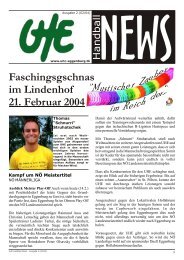"Vulkane am Äquator " (handout SS 2004) - hoststar
"Vulkane am Äquator " (handout SS 2004) - hoststar
"Vulkane am Äquator " (handout SS 2004) - hoststar
Sie wollen auch ein ePaper? Erhöhen Sie die Reichweite Ihrer Titel.
YUMPU macht aus Druck-PDFs automatisch weboptimierte ePaper, die Google liebt.
were still uninhabited when the first scientific mission arrived in 1790. The first eruption was<br />
recorded near the end of that century and the first resident settled in 1807. The Chilean<br />
islands were discovered, by Juan Fernandez in 1574, but no eruptions were recorded by<br />
their only early resident, Robinson Crusoe, during his 1704-09 visit: it remained for Charles<br />
Darwin to document the first (and only) historical eruption there in 1835.<br />
Recent volcanic activities<br />
Two volcanic crises in Ecuador beginning in September 1999 presented serious challenges<br />
to scientists monitoring them and to many of thousands of people living nearby. Eruptive<br />
activity at Volcán Guagua Pichincha, just west of the capital city of Quito (pop. 1.8<br />
million), increased significantly in mid 1999, and Volcán Tungurahua (about 100 km south<br />
of Quito) began to erupt in mid-September. By early October, both volcanoes were erupting,<br />
and explosions, ashfalls, and mudflows began to affect areas nearby and downwind.<br />
Guagua Pichincha<br />
Location: 0.17 S, 78.60 W<br />
Elevation: 4784 m<br />
after<br />
before<br />
Pichincha, 7. October 1999. Ash column arises above Guagua Pichincha volcano, Ecuador,<br />
minutes after an explosive eruption began in the summit crater (not visible from this view). The<br />
column rose to a height of about 16.5 km above sea level. Ash fell in Quito soon after, forming a<br />
layer 1-3 mm thick in northern parts of the capital city. This explosion and a similar one two days<br />
earlier blasted away part of the volcano's summit lava dome and sent pyroclastic flows 4-5 km down<br />
the volcano's west flank. During the month of October, 53 explosions sent smaller columns of ash<br />
into the atmosphere, nearly double the number of explosions during previous months.<br />
Guagua Pichincha is a stratovolcano which is located just 13 kilometers (~8 miles) west of<br />
Quito, the capital of Ecuador. The volcano had minor eruptions in 1981, 1982, 1997, and<br />
1998 but the last major eruption occurred in 1660 when the city of Quito was blanketed with<br />
30 centimeters (~1 foot) of ash. On the afternoon of October 5, 1999, Guagua Pichincha<br />
erupted sending large <strong>am</strong>ounts of ash over and onto Quito. The ash caused severe air<br />
quality problems and forced the closing of all commercial airports in and around the city.<br />
Two days later the volcano erupted again, this time in the morning.<br />
During most of 1999, activity at Guagua Pichincha consisted of many ste<strong>am</strong>-driven explosive<br />
eruptions and visible ste<strong>am</strong> plumes that rose tens to hundreds of meters above the dome.<br />
The magma added new material to the existing lava dome and led to stronger explosive<br />
activity and a few pyroclastic flows. In November and December, the growing dome<br />
produced more explosions, lava extrusions, and many rockfalls.<br />
7









